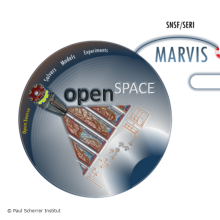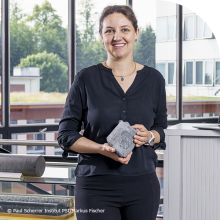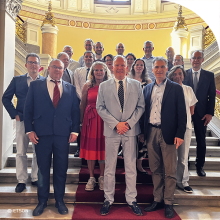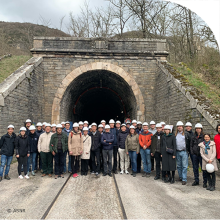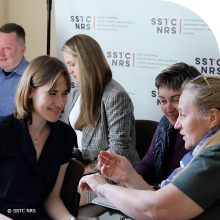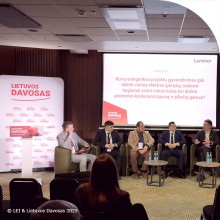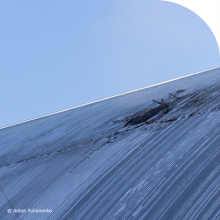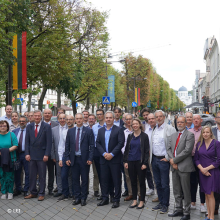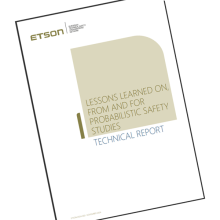News from ETSON and its members*
The PSI Laboratory for Reactor Physics and Thermal-Hydraulics (LRT) conducts computational and experimental research with focus on the safety of nuclear reactors and systems. In recent years, it established the EPSILON program to coordinate and consolidate its research activities on nuclear space applications. Among other things, developments were initiated towards an open-source European platform for high-fidelity simulations and experiments dedicated to space nuclear reactors. Referred to as the openSPACE platform, its underlying concepts are a) to include not only solvers but also reference simulation models as well as experimental validation data; b) to make all of these available to the broader and combined nuclear- and space communities for usage and/or further developments. Through this, the goal is thus not only to facilitate collaborative research in this area but also to enable effective support to the European Space Agency for thorough design, safety and performance evaluations of nuclear reactor systems for in-space propulsion and/or surface power. A first development phase focused on nuclear electric propulsion was proposed and retained among the two projects selected in 2023 by the Swiss National Science Foundation (SNSF) for its MARVIS call (Multidisciplinary Advanced Research Ventures in Space) and funded by the Swiss Secretariat for Research and Innovation (SERI). This project, to be conducted via four inter-connected PhD theses, was launched in October 2024 and this marks thus a key milestone for the propulsion of PSI nuclear research towards space.
Researchers at the Paul Scherrer Institute PSI have shown that artificial neural networks have the potential to determine very precisely the characteristics of rock layers, like their mineralogical composition, solely on the basis of drill core images. This could speed up future geological investigation efforts while simultaneously optimising costs.
The ETSON General Assembly convened on June 25-26, 2025, at the Academy of Sciences in Budapest, Hungary. Representatives from member organizations gathered to discuss key topics and make significant decisions for ETSON's future.
ANCHORS contributes to the safety assessment after the closure of geological disposal sites. It is part of the European partnership EURAD-2 (2024-2029), which brings together stakeholders in the research on radioactive waste management.
Crisis communication has become an integral part of the Ukrainian media space long before the full-scale invasion. Its importance was acutely felt in the spring of 2020, during the global COVID-19 pandemic. At that time, the media faced the need to convey information from official sources to the public in a prompt, objective, and responsible manner. The key task was to maintain public trust, prevent panic and ensure compliance with life-saving recommendations.
On March 19, 2025, the largest and most significant economic forum in the country, "Lithuanian Davos 2025," took place, traditionally gathering leaders from business, politics, and society. During the forum, there were not only standard sessions focusing on economic development, investment potential, accessibility of financing, and real estate market development, but also special sessions dedicated to the development of Lithuania's energy sector, defense industry. This 18th event featured a presentation "The Benefits of Small Nuclear Reactors: Where is the Value for the State?" by Dr. Tadas Kaliatka, the chief research associate at the Nuclear Equipment Safety Laboratory of the Lithuanian Energy Institute.
In April, the world traditionally remembers one of the worst man-made disasters in human history - the Chornobyl accident in 1986. This tragedy not only left a deep mark in the hearts of millions of people, but also changed approaches to nuclear safety around the world. But almost 40 years later, Chornobyl is once again in the spotlight - this time because of a threat that arose not from a technical failure but from armed aggression.
Concrete is the primary material used in waste management, making it essential for the concrete industry to develop more environmentally friendly and effective concrete formulations for handling radioactive and hazardous waste. This need is relevant for all countries around the Baltic Sea and beyond.
On 4th of June, 2024, members of EUROfusion gathered in Kaunas, the second-largest city of Lithuania for General Assembly, the quarterly meeting of the decision-making body of European consortium for fusion research, where progress towards realising fusion energy is discussed between the consortium members.
In many countries, Probabilistic Safety Assessments (PSA) form an integral part of the methods used to analyse the safety of nuclear power plants. Accordingly, a multitude of publications offers guidance on the use and development of PSA, e. g. those published by the International Atom Energy Agency or the Nuclear Energy Agency.
Pagination
Stay informed - subscribe to our newsletter.
Copyright · All rights reserved












